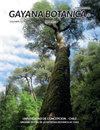Microcystis species and their toxigenic strains in phytoplankton of ten Bulgarian waterbodies
IF 0.5
4区 生物学
Q4 PLANT SCIENCES
引用次数: 3
Abstract
The summer phytoplankton structure of ten Bulgarian waterbodies was studied by HPLC analysis of marker pigments, light microscopy (LM) and PCR amplification of mcyB and mcyE gene sequences. The aim was to detect biodiversity and spread of toxigenic strains of potential microcystin producers and the important bloom-forming genus Microcystis in particular. The screening was done in three waterbodies, where Microcystis had already been found (Lakes Ezerets and Durankulak and Reservoir Koprinka), three waterbodies from which it had not been reported (Reservoirs Shilkovtsi, Zhrebchevo, Suedinenie) and four reservoirs that were sampled for the first time (Malka Smolnitsa, Plachidol 2, Preselka, Duvanli). LM and HPLC data similarly showed that cyanoprokaryotes contributed significantly to the total phytoplankton composition (29%) and biomass (15–87%) in nine sampled waterbodies. Microcystis aeruginosa, M. natans, M. smithii, M. wesenbergii, Microcystis spp., M. cf. comperei and M. pseudofilamentosa, were identified using LM (the last two tropical species were found for the first time in the country). Despite the low contribution of Microcystis to the phytoplankton diversity (1–4 taxa per sample) and to the total phytoplankton biomass (< 0.01–0.5%), 57 toxigenic strains of this genus were revealed by PCR, most of which demonstrated high similarity with NCBI M. aeruginosa and M. wesenbergii strains.保加利亚十个水体浮游植物中的微囊藻种类及其产毒菌株
采用高效液相色谱(HPLC)分析标记色素、光镜(LM)和PCR扩增mcyB和mcyE基因序列的方法研究了保加利亚10个水体夏季浮游植物的结构。目的是检测潜在微囊藻毒素产生菌的生物多样性和产毒株的传播,特别是重要的开花属微囊藻。筛选在三个已经发现微囊藻的水体(Ezerets湖、Durankulak湖和Koprinka水库)、三个未报告微囊藻的水体(Shilkovtsi、Zhrebchevo、sudinenie水库)和四个首次取样的水库(Malka Smolnitsa、Plachidol 2、Preselka、Duvanli)中进行。LM和HPLC数据同样表明,蓝藻原核生物对9个采样水体的浮游植物总组成(29%)和生物量(15-87%)有显著贡献。利用LM对铜绿微囊藻、M. natans、M. smithii、M. wesenbergii、M. comperei微囊藻和M. pseudofilamentosa微囊藻进行了鉴定(后两个热带种为国内首次发现)。尽管微囊藻对浮游植物多样性的贡献率较低(1 ~ 4个分类群/份),对浮游植物总生物量的贡献率也较低(< 0.01 ~ 0.5%),但PCR检测出该属57株产毒菌株,其中大部分与NCBI的M. aeruginosa和M. wesenbergii菌株具有较高的相似性。
本文章由计算机程序翻译,如有差异,请以英文原文为准。
求助全文
约1分钟内获得全文
求助全文
来源期刊

GAYANA BOTANICA
Agricultural and Biological Sciences-Plant Science
CiteScore
0.70
自引率
0.00%
发文量
8
审稿时长
6-12 weeks
期刊介绍:
The journal welcomes works carried out by scientists of all nationalities, and may be written in either English or Spanish. The journal receives works in systematic, taxonomy, floristic, ecology, physiology, morphology, development, conservation, cytology and phytochemical botany.
 求助内容:
求助内容: 应助结果提醒方式:
应助结果提醒方式:


